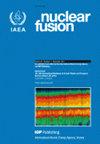Investigation of pedestal parameters and divertor heat fluxes in small ELM regimes in DIII-D
IF 4
1区 物理与天体物理
Q1 PHYSICS, FLUIDS & PLASMAS
引用次数: 0
Abstract
Divertor heat flux and its correlation with pedestal parameters within various small edge localized mode (ELM) regimes, including high beta poloidal, type-II and ELMs with negative triangularity H-modes were investigated in DIII-D. The parallel energy fluences of type-II and high beta poloidal small ELM regimes fall below the linear scaling with pedestal electron pressure for type-I ELMs put forward in Eich et al 2017 (Nucl. Mater. Energy12 84–90). The negative triangularity of H-mode ELMs follow the Eich scaling for type-I ELMs. The parallel heat flux and total heat loads to the divertor were determined using high-time resolution infrared thermography, while pedestal parameters were obtained through self-consistent kinetic equilibrium reconstructions. Linear regressions for the type-II and high beta poloidal regimes demonstrate that an equivalent 7.5 MA small ELM scenario in ITER would fall below the ~5 leading edge melting limit for tungsten (Gunn et al 2017 Nucl. Fusion57 046025). Utilizing fast thermography, the scrape-off layer power fall-off length for both inter-ELM and intra-ELM was determined and compared to the Eich scaling with poloidal magnetic field in Eich et al (ASDEX Upgrade Team and JET EFDA Contributors 2013 Nucl. Fusion53 093031). Except for the high beta poloidal scenario, all the small ELM regimes during both inter- and intra-ELM periods had power fall-off lengths larger then would be expected from the scaling associated with type-I ELMs, signifying their potential in managing heat loads and offering a solution for core–edge integration.对 DIII-D 小 ELM 状态下基座参数和分流器热通量的研究
在DIII-D中研究了各种小边缘局域模(ELM)状态下的掺杂热通量及其与基座参数的相关性,包括高β极性、II型和具有负三角形H模的ELM。II 型和高β极性小型 ELM 状态的平行能量通量低于 Eich 等人 2017 年提出的 I 型 ELM 与基座电子压力的线性比例(Nucl.)H 模式 ELM 的负三角形遵循 Eich 对 I 型 ELM 的缩放比例。分流器的平行热通量和总热负荷是通过高时间分辨率红外热成像确定的,而基座参数则是通过自洽动力学平衡重构获得的。II 型和高贝塔极坐标的线性回归表明,ITER 中等效的 7.5 MA 小型 ELM 方案将低于钨的 ~5 前缘熔化极限(Gunn 等 2017 Nucl.)利用快速热成像技术,确定了ELM间和ELM内的刮除层功率衰减长度,并与Eich等人的Eich缩放与极性磁场进行了比较(ASDEX升级团队和JET EFDA贡献者,2013 Nucl.Fusion53 093031)。除了高β极性情况外,所有小型ELM在ELM间期和ELM内期的功率衰减长度都比与I型ELM相关的缩放比例预期的要大,这表明它们在管理热负荷方面具有潜力,并为核边缘集成提供了一种解决方案。
本文章由计算机程序翻译,如有差异,请以英文原文为准。
求助全文
约1分钟内获得全文
求助全文
来源期刊

Nuclear Fusion
物理-物理:核物理
CiteScore
6.30
自引率
39.40%
发文量
411
审稿时长
2.6 months
期刊介绍:
Nuclear Fusion publishes articles making significant advances to the field of controlled thermonuclear fusion. The journal scope includes:
-the production, heating and confinement of high temperature plasmas;
-the physical properties of such plasmas;
-the experimental or theoretical methods of exploring or explaining them;
-fusion reactor physics;
-reactor concepts; and
-fusion technologies.
The journal has a dedicated Associate Editor for inertial confinement fusion.
 求助内容:
求助内容: 应助结果提醒方式:
应助结果提醒方式:


